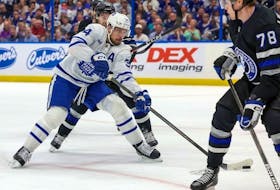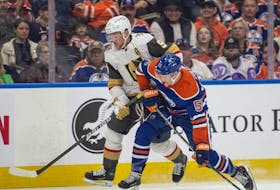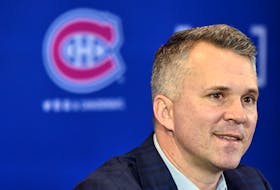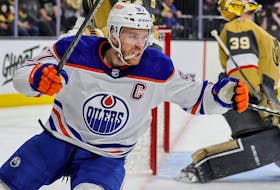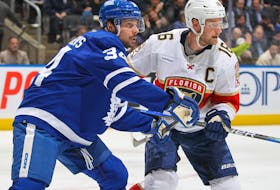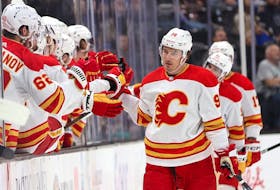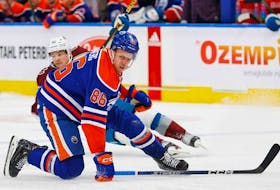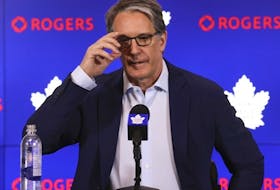
Across the country, minor hockey is quickly becoming synonymous with big business and over the last decade, more and more private operators have started to cash in on the boon.
It’s no different in this province, where several small, privately-run camps — some running over the course of a week, others for an hour or two per week over the course of several weeks — are filling the gap between the end of the minor hockey season in the spring and the start of the programs offered by some of the well-known and well-established hockey schools.
“In my 45 years of hockey, I’ve never seen so many,” says Randy Pearcey, co-owner and operator of Xtreme Hockey along with Andrew McKim, one of the largest private hockey operations on the island.
In addition to Xtreme, other major hockey camps include Andy Sullivan’s Eastern Flyers Hockey, Yetman's Action Hockey, operated by Pat Yetman, and Newfoundland Ice Dogs and Newfoundland Blizzard Hockey, owned and operated by Hockey Newfoundland and Labrador (HNL) president Jack Lee and Wally Bray.
“No question, it’s grown into something more than I ever thought it would,” says Lee, who has operated hockey schools in the province for 30 years. “When I first started doing hockey programs, I used to do three weeks (in the summer), now I’m doing six and seven.
“I didn’t want to expand, but the market expanded so I had no other choice.”
Lee, is hesitant, however, to refer to the fly-by-night operations that tend to show up in May and June and towards the end of summer as camps. Most of the people offering these programs are those who, in addition to enrolling their child or children in some of the mainstay schools like his, are just trying to get extra ice-time.
The programs generally cost between $150-$200, and range anywhere from a half-dozen to 12 hours.
“The reason you see so many of these pop up from different people is because of the availability of ice-time. From September to the end of April, you’re not going to see these because there’s no ice available,” Lee said.
“I don’t know if it’s lucrative as a business opportunity, or they’re just providing some opportunity for kids to play with kids at their own age and level when the main hockey programs are not operating.”
Throughout the regular season, Paul Dagg, HNL’s technical director, sometimes hears concerns about the limited amount of time kids receive on the ice, and the quality of instruction being offered by the minor hockey associations.
“The game has evolved so much that it’s to the point where kids are always trying to get on the ice and throughout the season, for some teams and some players, it’s tough to find ice,” Dagg says.
Still, there’s more fueling the industry than just a desire for a few more hours on the ice.
Pearcey calls it the one-up syndrome, where a parent feels as though his or her child will fall behind if they don’t enroll them in the same camp as one of their peers. By that rationale, both players are on even footing when minor hockey starts again in the fall.
What parents don’t realize, Pearcey suggests, is that, “we don’t make hockey players ... we just bring out the talent in them.
“I’ve had parents say to me that they’re going to this camp or that camp and they’ve asked what I think. I’ve said, ‘That’s your decision as a parent, but I wouldn’t do it.’ I’m not saying that because I don’t want to support another guy’s program. I don’t do it because I don’t think it’s necessary.
“All it is ice-time and ice-time doesn’t make the player.”
It begs the question — who is running these programs, and what qualifies them to provide minor hockey players with more instruction than what they are already receiving?
Private hockey operators are not regulated by Hockey Canada or any of its provincial branches, so in essence anyone who has the wherewithal to obtain ice rental can put one off, regardless of whether or not they are certified coaches.
“As long as you pay the bill at the end of the day, people are not going to tell you what to do,” says Lee.
Dagg believes, like coaches hired by HNL or within Hockey Canada, that there should be some degree of certification in order to instruct.
“A lot of what you see now is a guy who has been a hockey player, whether it’s junior or whatever, and can the play the game. But it’s a whole other basket if anyone’s been in front of a classroom or been on the ice teaching. Some guys freeze under that pressure, some guys excel,” he contends.
Pearcey, for instance, feels confident in his ability to teach the game, as a Hall of Fame player in his day but more importantly as a career spent teaching physical education before retiring and operating Xtreme on a full-time basis, and having learned from one of the greats, Howie Meeker, synonymous for his Howie Meeker Hockey School years ago as well as his Hockey Night in Canada work.
“He used to say to me, ‘Kid, you’ve got the skill’ and that’s one of the reasons why I went into becoming a teacher. I could take a skill and break it down, but that’s not important when it comes to these camps.”
But Lee suggests the emphasis at these quick camps is not on teaching the sport and developing better players.
“When kids do this type of stuff, they don’t want to be structured ... they want to go out and have some fun, play games. Most of the instruction is done throughout the winter.
“Most of the people I heard about are those that have their own son or daughter, a buddy’s son, they’ve got a couple of goalies, and they’ll throw 20 kids together and go out for a skate.”
Jim Hornell, chair of Hockey Canada’s board of directors and a native of Grand Falls-Windsor, calls it a, “buyer beware market.”
“I would encourage anyone, if they’re shopping around, to ask the kinds of questions you would if you were buying any other product or service,” Hornell said.
So are minor hockey players who spend their off-season, such as it is, availing of these programs actually gaining anything noticeable in the way of skill development?
That depends on who you ask and the program in question. Lee says he never sees a noticeable difference in those players who later attend his hockey school on a regular basis, but notes that other people might not see a difference in the same player after they finish with his program.
“It’s like any business, there’s always people popping up, but their longevity is in the quality of what they’re offering. If they’re not offering quality programs, they’re only hurting themselves and they’re not going to survive anyway.”
In his role as technical director, Dagg’s ear is sometimes bent towards private hockey operators, each with their own unique methods and, it seems, terminology.
“If they’re telling you to do a glided turnaround fluctuation stop, to me it just seems like a gimmick. They’re just coming up with their own terms so it’s something they can sell.”
Dagg acknowledges the game and the way it’s being taught is changing, “but at the same time, it’s not rocket science.”
As for whether kids need more than what their house league or all-star coach can offer, Dagg just wants the game taught correctly.
HNL is in the process of developing a website aimed at providing a simple way to teach the game.
“People ask, ‘Aren’t you worried that John Doe’s school is going to steal that?,’” Dagg says. “That’s fine, they can take any skating drills they want as long as they’re teaching the correct thing.”
No one is more concerned with the development of hockey players than Hockey Canada, and in recent years the national governing body has started to work with some of the “well-established and very credible” schools with hockey programs, explains Hornell.
St. Bon’s in St. John’s, for example, offers a Hockey Canada Skills Academy, operating since 2007.
“We work with schools to bring in skill academies where we actually do some of the training and help train on-ice instructors. It’s about schools working to develop non-traditional types of minor hockey programs, but working with us. We’re bringing our name, our experience to the table. We sort of maintain a quality control that there are reputable people providing a service.
“In some cases, these people are in competition to the programs that exists in minor hockey associations across the country, so there’s pressure to preserve the traditional minor hockey as well.”
On top of brand recognition and quality programs that even the International Ice Hockey Federation is using, a partnership with Hockey Canada also offers a, “very robust and comprehensive insurance program,” Hornell says.
“Do some of these entrepreneurs have the types of coverage we do? That is something parents, I think, should want to explore,” he said.
With so many new camps and programs popping up each year, Pearcey is concerned about the image of his business and admits that he often worries about negative experiences scaring off talented young players and their parents.
“A kid or parent might have a bad experience and say, ‘This is a joke, I’m not putting my kids into any of these programs.’”
Pearcey also suggests that the majority are not registered as a business, meaning they don’t pay any HST, and even more are not insured.
“If something happens (to the player), it’s your responsibility (as a parent). It’s an awful false way of going about things and the image is slighted by that alone,” he said.
His advice is the same as Hornell’s — do the research, then decide if your child or children will benefit from it.
“If I’m going to buy a pair of skates, I’m going to research the skates to see what’s right and wrong,” Pearcey said. “Parents are not doing that. They’re just putting their kids in programs for extra ice time. Little do they realize.”
Twitter@telykenn
Off-season becoming a thing of the past for some kids
It’s in Sport Canada’s Long-Term Athlete Development plan and to a man — from Hockey Newfoundland and Labrador technical director Paul Dagg, to Hockey Canada’s chairman of the board of directors, Jim Hornell, to private operators Randy Pearcey and Jack Lee — they all agree: more is not always better.
Yet year after year, when the minor hockey season clews up in the spring, some parents are scrambling to enroll their budding superstar in privately-operated hockey camps that crop up when ice-time becomes available, before the well-established hockey camps get their summer training programs off the ground.
“I personally don’t think there’s any reason for kids to be on the ice in June,” says Lee. “Sometimes kids need to get away from the rink and enjoy other sports because there’s too much pressure on kids today to perform at a high level all the time.
“They need to get away and have some fun.”
Lee says all parents and players alike need do is look to the professional ranks for proof.
“When they’re finished playing, they take a break from the game, they take a break from training, they take a break from thinking hockey. And these are professional athletes.”
Pearcey’s Xtreme hockey programs, for example, run end-of-season programs until the end of May, but the summer camps don’t open until nearly two full months later.
In recent years, Pearcey says he’s seen a lot of kids “get burnt out” from all the hockey.
“I’m not down on the parents — I’m running a business here — but I find that kids need time and space away from the rink to organize their own activities.”
Adds Dagg, “If you are solely driven toward hockey, your skills might start to lack elsewhere, and a lot of the good hockey players are multi-sport athletes.”
Hornell says while Hockey Canada wants people playing the sport for life, they recognize making it a 12-month commitment is not in the best interest of athlete development.
“You can create too many experiences in kids that can result in burnout and turn them away from the sport. We don’t want that to happen.”

